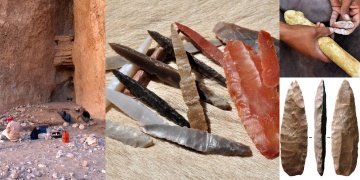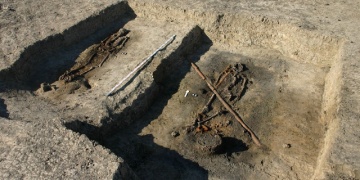![Oldest humans bed who 200 thousand years old]()
Early plant use by humans is not well studied because of poor preservation over time, however Border Cave's unique ecosystem has allowed for excellent preservation of this material - providing further insight into the lives of early humans in these…
![8.000 years old fluted stone tools discovered in Arabia]()
Stone fluted points dating back some 8,000 to 7,000 years ago, were discovered on archaeological sites in Manayzah, Yemen and Ad-Dahariz, Oman. Until now, the prehistoric technique of fluting had been uncovered only on 13,000 to 10,000-year-old…
![Two New Fellowships from ANAMED]()
DAI-ANAMED Joint fellowships in Environmental Archeology for Post- Doctoral scholars and the post-doctoral fellowships in geospatial and/or data sciences are now available.
![Ancient city of Hadrianopolis to be declared archeological site]()
The ancient city of Hadrianopolis in Turkey's Black Sea region, estimated to have been used as a settlement area in late Hellenistic, Rome and early Byzantine times, will become an archeological site.
![2020 is the year of Patara]()
Turkish President Recep Tayyip Erdogan announced 2020 as the year of Patara in a bid to promote and draw more attention to the ancient city and said 'I hope the year of Patara will be good for our country and the tourism sector'.
![Ox-driven cart sculpture and a three-piece Sidamara sarcophagus return to Turkey]()
Turkey will bring back two of its stolen artifacts from England, the country’s Ministry of Culture and Tourism said in a statement on Thursday.
![Ancient Siberian hunters created heat resistant pots]()
Hot pots helped ancient Siberian hunters survive the Ice Age
![Bone spoons who 3.800-year-old found in Mongolia]()
Ancient Mongolians used to make spoons out of bones, which traces back at least 3,800 years ago
![Piece of Viking sword and Roman coin found in Norway]()
Roman coin may redraw historic trade map
![Triple burial from Copper Age found in Croatia]()
The grave was found almost empty. Only a few sherds and a shell were recovered from the soil surrounding the burials, but they were probably part of the fill of the grave pit
![Eight hundred million years old fungal remains found]()
Mushrooms are older than thought
![Scorpion fossil who 437 million years old]()
Fossil is the oldest-known scorpion found 35 years ago in Wisconsin
![Blast turned brain to glass in Pompeii]()
The remains of a man lying on a wooden bed were discovered at Herculaneum, closer to Vesuvius than Pompeii, in the 1960s. He is believed to have been the custodian of a place of worship, the Collegium Augustalium.
![According to first building blocks; Lifes Frankenstein beginnings]()
A Model for the Emergence of RNA from a Prebiotically Plausible Mixture of Ribonucleotides, Arabinonucleotides, and 2'-Deoxynucleotides
![2000 year old burial unearthed in Laodicea Ancient city]()
2,000-year-old burial found near ancient city of Laodicea in SW Turkey
![Scandinavian warrior graves found in Poland]()
Archaeologist says; The Danish warriors would have been buried during the Piast dynasty – the first Polish dynasty to rule from the 10th century to the end of the 14th century.





























 Bir Sapiens kafilesi Avrupa'ya buz çağında ulaştı, soğuğa direndi ama soyunu sürdüremedi
Bir Sapiens kafilesi Avrupa'ya buz çağında ulaştı, soğuğa direndi ama soyunu sürdüremedi  Prof. Dr. Aytaç Coşkun: Zerzevan Kalesi'nin altında bir yeraltı kenti var
Prof. Dr. Aytaç Coşkun: Zerzevan Kalesi'nin altında bir yeraltı kenti var  Arkeologlar 4 Bin yıl önce salyangozların ne amaçla toplandığını çözmeye çalışıyor
Arkeologlar 4 Bin yıl önce salyangozların ne amaçla toplandığını çözmeye çalışıyor  Binbeşyüz yıl önce Balıkesir'de batan tabak yüklü geminin batığı bulundu
Binbeşyüz yıl önce Balıkesir'de batan tabak yüklü geminin batığı bulundu